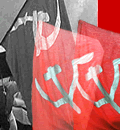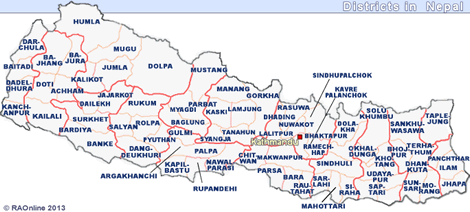|
Nepal's
goverment puts bounty on rebel heads April 2002 |
The
government of of Nepal has offered $64,000 each for the capture or killing
of three senior Maoist rebels. The bounty has been offered on the heads
of Maoist supremo Pushp KamalDahal, alias Prachand, Mohan Vaidya, alias
Kiran, and Baburam Bhattarai.
Anyone
giving information which leads to the capture of the three top rebels would
be rewarded half the bounty. The goverment is also offering cash incentives
to those rebels who surrender their weapons. It said rebels who surrendered
would be given security and efforts would be made to get them jobs. |
top
Indian
Union state Uttar Pradesh becoming shelter for Maoists
Indian
media: Maoists linked to Indian extremist groups April 2002 |
Indian
media reported that the explosives used in the recent Maoist attacks in
Achham and Salyan districts may have been stolen in two districts of West
Bengal, India. The Maoists must have received the explosives from the People's
War Group PWG and the Maoist Co-ordination Centre MCC, based in the Indian
states of Andhra Pradesh and Bihar. |
 The
northern Indian state of Uttar Pradesh bordering Nepal is fast becoming
a shelter for the embattled Maoists. The Uttar Pradesh police handed over
eight injured Maoists who were undergoing treatment in different private
clinics in Uttar Pradesh's capital city of Lucknow. The
northern Indian state of Uttar Pradesh bordering Nepal is fast becoming
a shelter for the embattled Maoists. The Uttar Pradesh police handed over
eight injured Maoists who were undergoing treatment in different private
clinics in Uttar Pradesh's capital city of Lucknow.
Indian
media reports that an increasing number of injured Maoist soldiers are
sneaking across the border into Uttar Pradesh for treatment. The Uttar
Pradesh state police has already deported several of them. Maoists have
increased their activities in villages situated along the Indo-Nepal border.
Many cross over into India to escape the Nepalese security forces.
 Indian police confirmed that MCC and PWG have stolen hundreds of detonators
and explosives over the years. MCC and PWGMCC and PWG rebels are working
in tandem to create problems in India's western region. Indian Police has
evidence of arms being routed to Kathmandu through Siraha, Dhanusha, Sindhuli
and Kavre districts. "Maoists are trying to set up a corridor from Nepal
to Andhra Pradesh through Bengal, Orissa and Jharkhand," an Indian police
officer said. According to the same sources, Maoists in Nepal and India
have been reported to be in close contact with similar-minded extremist
groups throughout the world. They had even participated in a meeting held
in India. The meeting had then formed an organisation called Co-ordination
Committee of Maoist Parties and Organisations of South Asia (CCOMPOSA). Indian police confirmed that MCC and PWG have stolen hundreds of detonators
and explosives over the years. MCC and PWGMCC and PWG rebels are working
in tandem to create problems in India's western region. Indian Police has
evidence of arms being routed to Kathmandu through Siraha, Dhanusha, Sindhuli
and Kavre districts. "Maoists are trying to set up a corridor from Nepal
to Andhra Pradesh through Bengal, Orissa and Jharkhand," an Indian police
officer said. According to the same sources, Maoists in Nepal and India
have been reported to be in close contact with similar-minded extremist
groups throughout the world. They had even participated in a meeting held
in India. The meeting had then formed an organisation called Co-ordination
Committee of Maoist Parties and Organisations of South Asia (CCOMPOSA).
 On
the international front, the Maoists have joined forces with South Asian
organisations to set up a Coordination Committee of Maoist Parties and
Organisation of South Asia (CCOMPOSA) with member groups from India, Nepal,
Bangladesh and Sri Lanka, including the MCC and Peoples' War Group in India.
The MCC, which is active in Bihar, is reported to have moved its bases
to Darbhanga near the Nepal border. A CCOMPOSA in Patna said the "groups
will unify and coordinate the activities of the Maoist parties and organisations
in South Asia". On
the international front, the Maoists have joined forces with South Asian
organisations to set up a Coordination Committee of Maoist Parties and
Organisation of South Asia (CCOMPOSA) with member groups from India, Nepal,
Bangladesh and Sri Lanka, including the MCC and Peoples' War Group in India.
The MCC, which is active in Bihar, is reported to have moved its bases
to Darbhanga near the Nepal border. A CCOMPOSA in Patna said the "groups
will unify and coordinate the activities of the Maoist parties and organisations
in South Asia".
|
top
Dang:
New Maoist raids
High
death toll of the rebels April 2002 |
Maoist
rebels launched simultaneous raids on an Armed Police Force (APF) base
in Sadbariya, an area police office in Lamahi and Bhalubang of Dang district.
The fighting took place along the country's main east-west highway. Officials
say at least 150 guerrillas were killed, although only 50 rebel bodies
have been recovered so far. The official casualty toll on the government
is 52, mostly policemen. The APF base camp in Sadbariya and the police
post in Lamahi are located along the busy East-West Highway and about 25
and 30-km south of Ghorahi, the district headquarters of Dang.
37
personnel of the APF were killed in the Sadbariya raid. There were 120
police personnel in Sadbariya. Some security personnel sustained serious
injuries while eight others were still missing after a fierce battle that
lasted about five hours. The rebels looted some self-loading rifles and
light machine guns from the base camp. |
 In another raid, the Maoist guerrillas killed nine policemen in Lamahi-based
area police outpost. The rebels also looted an high amount in cash
and other valuables from two banks in Lamahi bazaar. The rebels had earlier
blocked the busy highway and a link road to Ghorahi by felling big trees
and laying landmines at several places to prevent the government reinforcements
from reaching the battle sites. Locals said that the rebels had also exchanged
fire with security personnel in Ghorahi, Tulsipur Municipality and Bhalubang
to divert the attention of the security forces from Lamahi and Sadbariya. In another raid, the Maoist guerrillas killed nine policemen in Lamahi-based
area police outpost. The rebels also looted an high amount in cash
and other valuables from two banks in Lamahi bazaar. The rebels had earlier
blocked the busy highway and a link road to Ghorahi by felling big trees
and laying landmines at several places to prevent the government reinforcements
from reaching the battle sites. Locals said that the rebels had also exchanged
fire with security personnel in Ghorahi, Tulsipur Municipality and Bhalubang
to divert the attention of the security forces from Lamahi and Sadbariya.
 Four
civilians travelling in night buses from Kathmandu were also killed in
the crossfire in Bhalubang, about 25-km east of Lamahi. The rebels had
also attacked a sub-station of the national power grid resulting in disruption
of power supply to the mid-and far-west Nepal. Four
civilians travelling in night buses from Kathmandu were also killed in
the crossfire in Bhalubang, about 25-km east of Lamahi. The rebels had
also attacked a sub-station of the national power grid resulting in disruption
of power supply to the mid-and far-west Nepal.
 Security
forces recovered arms in a private bus which was captured by the rebels.
All the firearms and ammunition were looted by the rebels from Satbariya
Armed Police Force (APF) base camp and an area police office in Lamah.
The Maoist rebels were travelling in the captured bus from Ghorahi
of Dang to Pyuthan when the scurity forces clashed with them in the Mukatti
area. Security
forces recovered arms in a private bus which was captured by the rebels.
All the firearms and ammunition were looted by the rebels from Satbariya
Armed Police Force (APF) base camp and an area police office in Lamah.
The Maoist rebels were travelling in the captured bus from Ghorahi
of Dang to Pyuthan when the scurity forces clashed with them in the Mukatti
area.
 Near
Gojhena village Maoist rebels unearthed some bodies of their comrades from
six ditches on the banks of the Rapti Khola and took them away towards
the other side of the river. The names of killed persons are not known.
Security officials suspect that more rebel bodies could have been dumped
in the Chure range. Near
Gojhena village Maoist rebels unearthed some bodies of their comrades from
six ditches on the banks of the Rapti Khola and took them away towards
the other side of the river. The names of killed persons are not known.
Security officials suspect that more rebel bodies could have been dumped
in the Chure range.
Decayed
bodies of the Maoist rebels were still lying scattered in the open field
of Hattikhal area near the battlefield of Satbariya.The bodies should dumped
properly, locals said. they fear an epidemic.
|
top
|






